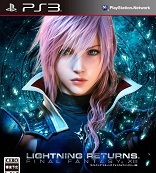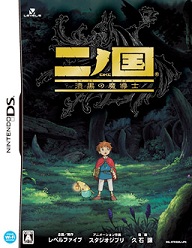Front Mission
Nintendo DS
Reviewed: 12/01/2007
 Front Mission for the DS is a slightly upgraded version of two games that never reached North American shores: Front Mission and Front Mission: Gun Hazard, both of which appeared on the Super Famicom.
Front Mission for the DS is a slightly upgraded version of two games that never reached North American shores: Front Mission and Front Mission: Gun Hazard, both of which appeared on the Super Famicom.
Front Mission tells the story of a war (The Second Huffman Conflict) between the Unified Continental States (U.C.S.) and the Oceania Cooperative Union (O.C.U.). At the beginning of the game, players get the choice of playing through the game from either perspective. Thus, players will take control of either Royd (O.C.U.) or Kevin (U.C.S.) and guide them with a team of allies through a storyline that is surpisingly deep. Front Mission features a truly epic story that spans dozens of hours in length. The fac that the story has many real locations only serves to make it feel more authentic. The story presented in Front Mission is perhaps most succesful because the characters themselves feel human. While some characters could definitely have used more depth, the amount of development that some characters get is astounding. The exploration of the conflict itself is an incredible experience. There are certainly flaws in the game’s storyline–including a few blatant plot holes–but overall the story was superb. The fact that there are two entire storylines featured here also adds to the replayability aspect of the game.
 |
| Johnny is so angry. |
The battle system of Front Mission will not be setting any new standards for SRPGs, but that is mostly because it’s a port from the Super Nintendo. That said, they’re pretty basic affairs. Players control a group of wanzers (the game’s term for a mecha) and lead them through a series of isometric maps, destroying everything in their path. There are a few nuances to the system. Most mechs carry both long-ranged and melee or short-ranged weapons, which means players must pay more attention to weapon ranges than in other SRPGs. Another unique aspect in battle is that wanzers are made up of several parts, they are not just one HP bar waiting to be destroyed. Wanzers are split into four parts: the legs, the right and left arms, and the body. Each of these parts can be destroyed independently, and only the body results in the destruction of the unit. This brings a whole new aspect of strategy to the game, as destroying a wanzer’s arms will make it harmless, so players must pay attention to both their own units’ parts as well as deciding on how to best go about incapacitating the enemies on the map.
There are some flaws in Front Mission‘s battle system, most of which are nagging details that victimize the game, again due to the fact that it was originally made quite some time ago (1995, to be exact). The main gripe here is that the maps don’t rotate. This is an issue that continually frustrates, as it keeps showing up, even in other modern SRPGs. SRPGs that do not allow for rotation of maps nowadays, especially without allowing adequate vision of it sans-rotation, simply seem ancient by default. The fact that many of the maps throughout Front Mission have terrain that can hide enemies behind them is another annoyance that could easily be avoided by having rotation on the maps. The game does try to correct this by fading terrain and buildings out when the cursor is behind them, but this still doesn’t fully solve the issue sometimes. The overall simplicity of the battle system is another issue. This is not to say the game is easy by a long shot–indeed, it is a fairly difficult game–but there just aren’t too many innovations going on that would make the game really stand out.
Front Mission features one of the best uses of the DS’s touch screen for an SRPG to date, and using a stylus actually saves time in this game. The control is fluid, and despite how small the squares are on the map, rarely will one have problems getting the wanzers to go exactly where they’re supposed to. The only minor gripe about the touch control is that selecting targets sometimes requires an extra tap for some reason. Overall, the game can easily be played fairly easily using just the touch screen. On the other hand, the touch screen is not required to play at all, which is an added bonus for players that don’t like to have to hold on to a stylus.
 |
| Buildings are often in the way. |
One thing that does seperate Front Mission from the pack is that unlike most strategy RPGs, during which most of the time spent with the game is spent in battle, Front Mission encourages players to spend copious amounts of time customizing their wanzers. Essentially, players must decide how to build their squad in order to best defeat the enemy. There is an astouding variety of possible setups for each individual wanzer, and the characters themselves are also a consideration in customization, as most characters have stats that lean towards an archetype from the get-go. For example, a character that has a 451 rating in long-ranged attacks, but 100s in every other category at acquisition would best be paired with a wanzer that has a pair of rocket launchers on it, thus allowing the character to fully take advantage of the firepower he/she is given. The customization isn’t just about weapons, however, as the entire wanzer can be customized piece by piece. Different sets of legs offer varying movement rates and capabilities. Some arms come with a weapon already attached. One body may have more HP, but not be able to carry as much weight around. The considerations that must go into customization are immense in number. There is an option to let the computer automatically customize ones wanzers for them, but this takes away from a huge part of the joy the game has to offer. The customization in Front Mission is second to none.
Graphically, Front Mission is nothing to get too excited about. Oftentimes, it is quite obvious that the game is essentially a port of a Super Nintendo game. This isn’t to say it looks bad, but it is true that the DS can produce much better visuals than those seen in this game. The soundtrack is pretty good. There are a few memorable tunes, but nothing that is really epic. The sound effects are appropriate, but again, nothing that will astonish.
Front Mission is arguably the best SRPG currently available on the Nintendo DS. The battle system is solid, the story is great, and the depth of the customization adds a huge amount of playability to the game. Players that don’t like the thought of hours of reconfiguring mechs to make the best possible killing machine may want to look elsewhere, but those who enjoy a solid SRPG with some great options are bound for a treat.
-Joseph Wartick
| Score Breakdown | ||
| Overall Very Good Out of 10 See our Review Criteria |
Gameplay | Great |
| Story | Very Good | |
| Graphics | Average | |
| Sound/Music | Good | |
| Replay Value | Great | |
| The Verdict: 7 | ||








